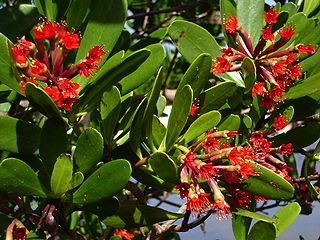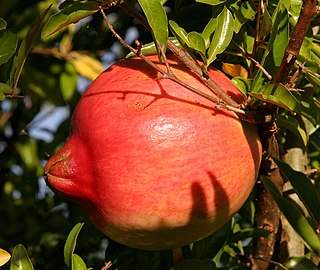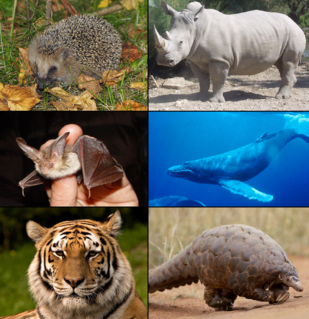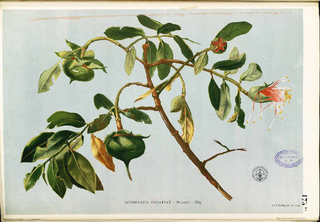Related Research Articles

The Myrtales are an order of flowering plants placed as a sister to the eurosids II clade as of the publishing of the Eucalyptus grandis genome in June 2014.

The Pelecaniformes are an order of medium-sized and large waterbirds found worldwide. As traditionally—but erroneously—defined, they encompass all birds that have feet with all four toes webbed. Hence, they were formerly also known by such names as totipalmates or steganopodes. Most have a bare throat patch, and the nostrils have evolved into dysfunctional slits, forcing them to breathe through their mouths. They also have a pectinate nail on their longest toe. This is shaped like a comb and is used to brush out and separate their feathers. They feed on fish, squid, or similar marine life. Nesting is colonial, but individual birds are monogamous. The young are altricial, hatching from the egg helpless and naked in most. They lack a brood patch.

A sepal is a part of the flower of angiosperms. Usually green, sepals typically function as protection for the flower in bud, and often as support for the petals when in bloom. The term sepalum was coined by Noël Martin Joseph de Necker in 1790, and derived from the Greek σκέπη, a covering.

Eutheria is one of two mammalian clades with extant members that diverged in the Early Cretaceous or perhaps the Late Jurassic. All placental mammals are eutherians. Extant eutherians, their last common ancestor, and all extinct descendants of that ancestor are members of Placentalia.
In human genetics, the Y-chromosomal most recent common ancestor is the most recent common ancestor (MRCA) from whom all currently living males are descended patrilineally. The term Y-MRCA reflects the fact that the Y chromosomes of all currently living human males are directly derived from the Y chromosome of this remote ancestor. The analogous concept of the matrilineal most recent common ancestor is known as "Mitochondrial Eve", the most recent woman from whom all living humans are descended matrilineally. As with "Mitochondrial Eve", the title of "Y-chromosomal Adam" is not permanently fixed to a single individual, but can advance over the course of human history as paternal lineages become extinct.

Punica is a small genus of fruit-bearing deciduous shrubs or small trees in the flowering plant family Lythraceae. The better known species is the pomegranate. The other species, the Socotra pomegranate, is endemic to the island of Socotra. It differs in having pink flowers and smaller, less sweet fruit.

Lythraceae is a family of flowering plants, including 32 genera with about 620 species of herbs, shrubs and trees. The larger genera include Cuphea, Lagerstroemia (56), Nesaea (50), Rotala (45), and Lythrum (35). It also includes the pomegranate and the water caltrop. Lythraceae has a worldwide distribution, with most species in the tropics, but ranging into temperate climate regions as well.

The simians or anthropoids or higher primates are an infraorder of primates containing the parvorders Platyrrhini and Catarrhini, which consist of the superfamilies Cercopithecoidea and Hominoidea.

Lythrum is a genus of 38 species of flowering plants native to the temperate world. Commonly known as loosestrife, they are among 32 genera of the family Lythraceae.

The common gamma chain (γc), also known as interleukin-2 receptor subunit gamma or IL-2RG, is a cytokine receptor sub-unit that is common to the receptor complexes for at least six different interleukin receptors: IL-2, IL-4, IL-7, IL-9, IL-15 and interleukin-21 receptor. The γc glycoprotein is a member of the type I cytokine receptor family expressed on most lymphocyte populations, and its gene is found on the X-chromosome of mammals.

Boreoeutheria is a clade (magnorder) of placental mammals. It is composed of the sister taxa

Duabanga is a small genus of lowland evergreen rainforest trees in southeast Asia, comprising two or three species.

T7 RNA Polymerase is an RNA polymerase from the T7 bacteriophage that catalyzes the formation of RNA from DNA in the 5'→ 3' direction.

Sonneratia is a genus of plants in the family Lythraceae. Formerly the Sonneratia were placed in a family called Sonneratiaceae which included both the Sonneratia and the Duabanga, but these two are now placed in their own monotypic subfamilies of the family Lythraceae. The genus was also named Blatti by James Edward Smith, but Sonneratia had botanical nomenclature priority. Sonneratia species are mangrove trees. The germination is viviparous.
This is the named Melchior system, "a reference in all taxonomic courses", detailing the taxonomic system of the Angiospermae according to A. Engler's Syllabus der Pflanzenfamilien (1964), also known as "modified or updated" Engler system.

The interleukin-7 receptor is a protein found on the surface of cells. It is made up of two different smaller protein chains - i.e. it is a heterodimer, and consists of two subunits, interleukin-7 receptor-α (CD127) and common-γ chain receptor (CD132). The common-γ chain receptors is shared with various cytokines, including interleukin-2, -4, -9, and -15. Interleukin-7 receptor is expressed on various cell types, including naive and memory T cells and many others.

Homeobox protein DLX-6 is a protein that in humans is encoded by the DLX6 gene.

Bernhard Adalbert Emil Koehne was a German botanist and dendrologist born near Striegau, a town known today as Strzegom, Poland.
The APG III system of flowering plant classification is the third version of a modern, mostly molecular-based, system of plant taxonomy being developed by the Angiosperm Phylogeny Group (APG). Published in 2009, it was superseded in 2016 by a further revision, the APG IV system.
Shirleya is an extinct genus in the crape myrtle family, Lythraceae, which contains a single species, Shirleya grahamae. The genus and species are known from Middle Miocene fossils found in Central Washington.
References
- Little S. A.; Stockey R. A. & Keating, R. C. (2004). "Duabanga-like leaves from the Middle Eocene Princeton chert and comparative leaf histology of Lythraceae sensu lato". American Journal of Botany. 91 (7): 1126–1139. doi: 10.3732/ajb.91.7.1126 . PMID 21653468.
| This Myrtales article is a stub. You can help Wikipedia by expanding it. |